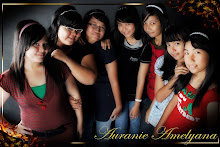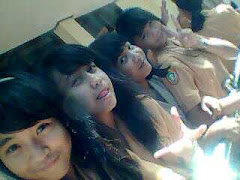Welcome to my e-Primbon Part 2. !!
Special thanks to my teacher, Mr. Erwanto, and my classmate, G'teven who have helped me to finished this e-Primbon Part 2. . .
Well, I hope this can be useful for us and can also add to our knowledge ..
Oke...
Let's check it out. !! :D
Sabtu, 27 Februari 2010
Hello Guys. !
TABLE OF CONTENTS
1. Invitation ( Writing )
2. Vocabulary Around The House
3. Gratitude, Comliment, and Congratulation
4. Surprise and Disbeliefs
5. Asking For Information
6. Narrative
7. Modals In The Past Form
8. Direct and Indirect Speech
9. Descriptive Text
10. Introductory It
11. News Item
12. Finite Verbs
13. Noun Phrase
14. Simple Future
15. Offering
16. Asking If Someone Remember or Not
17. Passive Voice
18. Prepotition In, On, It
Jumat, 26 Februari 2010
1. INVITATION (WRITING)
Invitation is a way to invite someone or more to go to a place or to do something.
There are two types of invitation.
They are Formal Invitation and Informal Invitation.
-Formal invitation is usually originate from Institutes, Companies and a kind of it. Normally formal invitation is written invitation.
-Informal invitation is personal invitation given to a friend, family, etc. Informal invitation can be written invitation and verbal invitation.
How to Write An Invitation??
Step 1
Before you write an invitation, decide on the tone, voice and level of formality, based on the event itself. This will dictate whether you hand-write the cards or have them printed, and whether you choose A preprinted or personalized invitation.
Step 2
Choose the type of invite you want, and order or buy a few more than you think you'll need. This will permit you to add some guests to your list at the last minute, if necessary. For small parties, you may want to hand-write the invitations on stationery or blank cards. For large gatherings, consider ordering printed invitations.
Step 3
Determine the wording of your invite based on the level of formality. For example, a formal invitation might say, 'Dr. and Mrs. Stanley request the pleasure of your company,' whereas a more casual note might say, 'Please join us.'
Step 4
Include the names of the host and/or hostess, as well as the place (with street address), time, date and purpose of the occasion, even if it's a simple get-together.
Step 5
Make sure to add RSVP information at the bottom of the invite if you need to know who will be attending; for example, 'RSVP' followed by your telephone number.
R.S.V.P. which means "please reply.“The person sending the invitation would like you to tell him or her whether you accept or decline the invitation. That is, will you be coming to the event or not?
Step 6
Include a respond-by date on a formal invitation so you can get an accurate head count in time to adjust the amount of food, number of place settings and room size. For a wedding, charity function or other formal event, consider including a response card and a stamped, self-addressed envelope inside the envelope containing your invite.
Step 7
Mail invitations three weeks before most events, four weeks before a formal affair and three months before a wedding, to allow for airline reservations. For events held during the December holidays, send invitations around Thanksgiving.
- Extending (mengundang)
- Let’s go to the Keroncong Festival!
- Please try to come!
- I hope you’ll join us!
- If you are not busy, pleset come to my party!
- Shall we see the film?
- I would like to invite you come to my house!
Accepting (menerima)
- Great! Let’s do it!
- Thank you. I’d like to!
- That’s a good idea!
- That would be very nice!
- Thank you for invitation!
Declining (menolak)/refusing:
- I’m really sorry about that.
- Sorry. I can’t. I have to do something.
- I’d love to. But I can’t.
- Sorry. I really busy.
- (If you declining an invitation, please give a reason) readmore »»
2. VOCABULARY AROUND THE HOUSE
 Build Up :
Build Up :
Attic =People store things in the attic.
Box Room =A small room used for storage.
Cellar =Underneath the house.
Cloakroom =A small room where people put their coats.
Conservatory = A greenhouse attached to a house for the display of plants.
Drawing Room =A room in stately homes where rich people entertain.
Hall = The entrance passage to a house.
Parlour =Old fashioned word for living room.
readmore »»
3. GRATITUDE, COMPLIMENT AND CONGRATULATION
Gratitude is also called thanking.
We say “thank you” when people give us something, help we do something, give a compliment, wish us something, etc.
Expressing gratitude:
- I should like to express my gratitude
-Thank you very much
- Thanks for your help
-How can I thank you?
-I’m very grateful to you
-I can’t thank you enough
-I’m very much obliged to you.
Responding:
- It was the least I could do
- You’re welcome
- No big deal
- Don’t mention it
- It’s a pleasure
- That’s all right
- Any time
Compliment is expression that use to give praising to other people.
Some people use compliment to butter up somebody or to flatter in order to increase good will.
Complimenting:
- Good grade!
- Nice work
- Excellent!
- Good job!
- You look great
- What a nice t-shirt
- I really must express my admiration for your dance
- You look very nice (beautiful/handsome)
Congratulation is expression that used to said congratulate to someone when get a success.
Congratulating:
- I must congratulate you
- Please accept my warmest congratulations
- I’d like to be first to congratulate you
- Congratulations on your success
- Congrats! Finally, your dream comes true!
4. SURPRISE AND DISBELIFS
Surprises or disbeliefs is an expression that we show/ say when know/ hear/ see something that rather difficult to believe.
* To express surprise :
- What a surprise !
- That's a surprise !
- (Well), that's very surprising !
- Really ?
*Responding to express surprise :
- Yeah !
- It is
- Yup
- Sure
*When you got a surprising fact, you can say :
- Do you know what ?
- Believe it or not ?
- You may not believe it, but...
- Can you believe this ?
Example of exressing surprise :
Nila : Whose motorbike is that ?
Sisy : It's Nicko's
Nila : Are you kidding me ?
Sisy : No. I'm not. I saw he riding that motorbike this morning.
Nila : What a surprise !
*To expressing disbelief :
- I don't believe it
- It can't be true
- I can't think of it
- I don't trust you
Example of expressing disbeliefs :
Dewi : Do you know ? You get the best score at English test!
Pamela : What ? I don't believe that.
Dewi : This is fact !
Pamela : Woow! That's very surprise !
5. ASKING FOR INFORMATION
There are a number of formulas used when asking for information in English. Here are some of the most common:
* Could you tell me...?
* Do you know...?
* Do you happen to know...?
* I'd like to know...
* Could you find out...?
* I'm interested in...
* I'm looking for..
These two forms are used for asking for information on the telephone:
* I'm calling to find out...
* I'm calling about...





